Salton Sea, Imperial Valley, & Laguna Mts. - Feb 2008
by
Henry Detwiler
Four visits to this area in February produced a smorgasbord of great birds
164 species--bird list is at the bottom of the page
Click on
thumbnail pictures for full-sized photos.

| Our first stop was usually Rio Bend RV Golf Course, where Vermilion Flycatchers and a wintering Tropical Kingbird awaited us. The resort sits on a bluff overlooking Fig Lagoon, so we'd scope the water for shovelers and other ducks. On the other side of I-8, Sunbeam Lake held a fine array of waterfowl, including these two tame (but wild) geese, who settled into morning bread feedings. |

Vermilion Flycatcher |
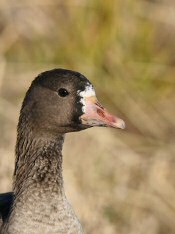
White-fronted Goose
|
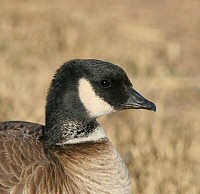
Cackling Goose
|
| Half an hour uphill from Sunbeam Lake takes you to Jacumba, in the lower portion of the Laguna Mountains. And fifteen minutes beyond is Live Oak Springs with even more evergreen habitat. Here you'll find a lot of birds which rarely if ever make it down into the super-heated Imperial Valley. California Quail, Red-shouldered Hawk, Nuttall's & Acorn Woodpeckers, Oak Titmouse, California Thrasher, Tricolored Blackbird, California Towhee, Pine Siskin, and Cassin's Finches all put in an appearance during our visits there. |
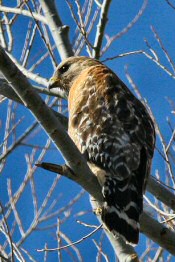
Red-shouldered Hawk |
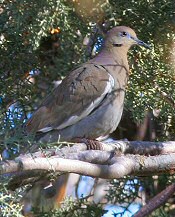
White-winged Dove - wintering (?) in Jacumba
|
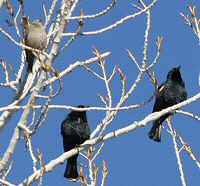
Tricolored Blackbirds -
A common sight in Jacumba this winter |
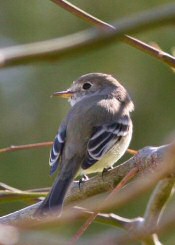
Gray Flycatcher
|
Back down in the Imperial Valley we visited Cattle Call Park in Brawley, where we were happy to find Gray Flycatcher, Red-naped Sapsucker, Gila Woodpecker, Cactus Wren, Costa's Hummingbird, Abert's Towhee, and Vermilion Flycatcher. |
At the corner of Davis & Shrimpf Roads we visited and explored a few of the bubbling mud pots, evidence of the extreme geothermal activity in the area. |
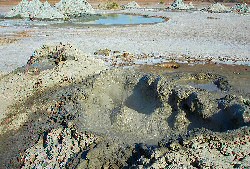
Mud Pots
|
|
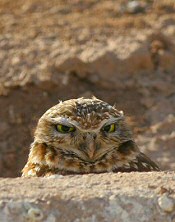 Burrowing Owl
Burrowing Owl
|
The Imperial Valley is justifiably proud of its population of Burrowing Owls. In the late spring it's not uncommon to count over 100 of these cute birds in the course of a morning. During the winter they are somewhat harder to come by, so we were happy to see several peering out of their burrows and over berms.
|
The numerous fields, dirt edges, and drainage ditches around the Salton Sea and throughout the Imperial Valley provide a lot of habitat for mice, gophers, and other rodents. This large prey base is one reason for the large number of raptors, including these larger owls. Twice we found this Great Horned Owl roosting in an abandoned grain silo. Similarly, we found this Barn Owl twice in an abandoned ranch house.
|
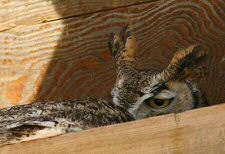
Great Horned Owl

Barn Owl flying away
|

Cinnamon Teal
|
At the corner of Lack and Lindsey is a small freshwater pond that regularly hosts waders, waterfowl, gulls, and shorebirds. During all of February it played host to Cinnamon, Green-winged, and Blue-winged Teal. Then at the beginning of March, I heard that a Long-tailed Duck took up residence there.
|
On our last afternoon at the Sea, the winds were blowing fiercely. It whipped the water into a brownish foamy broth--not at all appealing. But it was entertaining to watch the Eared Grebes bobbing up and down on the never-ending waves.
|

Eared Grebes riding the surf!
|
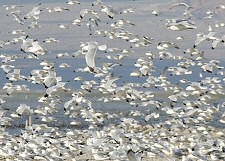
Red Hill Marina Gulls
|
Thousands of Northern Shovelers were in the Salton Sea at the end of Garst Road. In the bay around Red Hill Marina and on the Sea to the west were tens of thousands of Rind-billed and California Gulls, with lesser numbers of Herrings. Occasionally a harrier would drift by and shuffle them around. |
In the refuge fields at Unit 1 we watched thousands of Snow and Ross's Geese; on one trip we were lucky to see a rare blue morph Ross's Goose. On another trip we had five Tundra Swans in a wet field and flushed an American Bittern in the cattail marshes. During the final trip to this great area the geese were joined by a good-sized flock of Sandhill Cranes. From the observation platform we looked out on a sea of birds: pelicans, ducks, terns, and shorebirds. The birding is always good--it just changes from day to day!
|
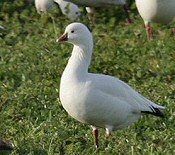
Ross's Goose
|
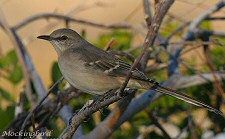
Northern Mockingbird at Rio Bend RV Park
|